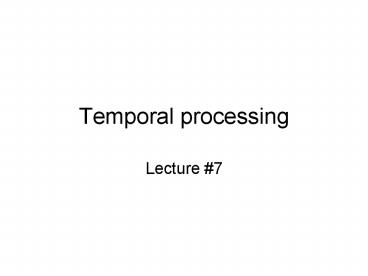Temporal processing - PowerPoint PPT Presentation
1 / 19
Title:
Temporal processing
Description:
Temporal modulation transfer function (shows sensitivity to modulation depth as ... Hearing aids alter spectral & temporal properties ... – PowerPoint PPT presentation
Number of Views:161
Avg rating:3.0/5.0
Title: Temporal processing
1
Temporal processing
- Lecture 7
2
Gap Detection
Signal
Time (s)
3
Duration discrimination
Signal
Time (s)
t ?t
t
4
Forward backward masking
5
Modulation Detection
Trial with 100 Modulation
Amplitude
Trial with Less Modulation
Trial Begins
Stimulus?
Stimulus?
Stimulus?
Stimulus?
.5
0
1
2
3
Time (s)
6
Modulation Frequency
2 Hz
8 Hz
64 Hz
0
1
Time (ms)
7
Temporal modulation transfer function (shows
sensitivity to modulation depth as a function of
modulation frequency)
8
Modulation detection
Modulation detection
Speech recognition
Boike, 2004
9
Modulation Masking Example
Signal
Masker
Trial Begins
Stimulus?
Stimulus?
.5
0
1
2
3
Time (s)
10
Modulation masking/modulation interference
11
Modulation masking
Speech recognition
Modulation masking
Boike, 2004
12
Temporal integration. We can detect long signals
better than short signals. There is little
effect of duration above about 200 ms.
13
Hearing aids alter spectral temporal properties
Unprocessed
Single-channel compression plus NAL-prescribed
gain
The ear is an important sense organ
14
the ear is an imp ort ant sense or
g an
Amplitude (dB)
Time (seconds)
2 sec
The ear is an important sense organ
15
Noise
Amplitude (dB)
Time (seconds)
2 sec
16
(No Transcript)
17
Psychoacoustics in older listeners
18
Sensitivity to temporal cues needed for speech
identification decreases with age
CVC syllables processed to restrict spectral
cues Differentiating cues are temporal
modulation, duration, gaps Older listeners
perform worse when dependent on temporal cues
Souza Boike 2006
19
Sensitivity to temporal cues needed for speech
identification decreases with age
Cash vs. Catch differentiating cue is
silent gap Older adults have poorer speech-gap
detection than young
Haubert Pichora-Fuller, 1999 Schneider et al.,
2002 (redrawn)































